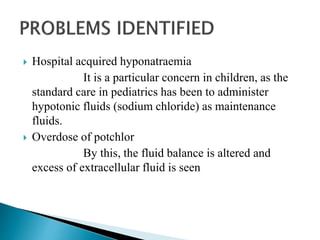Case on dengue like illness with hyponatraemic seizures
- 1. Presented by : B.Sunil Kumar Nayak
- 2. Patient Name : XYZ Age : 6 Yrs Sex :Male Weight :16 Kgs Unit : Paediatric Ward
- 3. ’üĮ C/O Fever since 5 days gradual in onset, low-grade, continuous and relived with medication. ’üĮ History of vomiting 3 episodes/day, which is non- progressive 1 week back and pain in abdomen and cough.
- 4. ’üĮ MEDICAL HISTORY :- History of birth asphyxia ’üĮ MEDICATION HISTORY :-Syp.Paracetamol ’üĮ FAMILY HISTORY :-Nothing significant ’üĮ SOCIAL HISTORY :-Nothing significant
- 5. S - Subjective Evidence O - Objective Evidence A - Assessment P - Planning
- 6. ’üĮ PROVISIONAL DIAGNOSIS:- Fever under evaluationŌĆ”.?
- 7. Dengue test : Negative Widal test : Negative M.P Examination : Negative Platelet count : 75k (1.70-4.50 L/cumm) Hb : 8.7 g/dl (11-16.5) Sr.Sodium : 124 m.mol/lit (135-145) Sr.Potassium : 4.7 m.mol/lit(3.5-5.0) Sr.Chlorides : 93 m.mol/lit( 90-110) FINAL DIAGNOSIS:- DENGUE LIKE ILLNESS WITH HYPONATRAEMIC SEIZURES
- 8. ’üĮ To maintain the body temperature ’üĮ To relieve from vomitings ’üĮ To prevent the reoccurance of the seizures
- 9. S.I NO DRUGS (Generic names) DOSE ROA FRE DA DS 1 N.S 1 pint I.V 1 4 2 Sod.citrate, Pot.chloride, Sod.chloride, Dextrose 1 sachet in 200ml water PO - 1 4 3 Syp.Paracetamol 250mg PO TID 1 4 4 Inj.Ondansetron 2cc IV SOS 1 4 5 Inj.Artesunate 48mg IV OD 2 4 6 Inj.Cefotaxim 800mg IV BID 3 4 7 Inj.Paracetamol (if temp > 102F) 500mg IV SOS 3 4 8 Tab.Artesunate+Pyrimethamine+Sulfadoxi me 200+2.5+50 0mg PO OD 4 4
- 10. S.I NO DRUGS DOSE ROA FREQ DA DS 9 Inj.Midazolam 1.5cc+0.5ccNS Slow IV OD 4 4 10 Inj.Phenytoin 40mg+100cc NS Slow IV BD 4 7 11 Inj.Ceftriaxone 800mg IV BD 4 8 12 Inj.Vit-K 5mg IV Stat 4 4 13 Inj.Ranitidine 3mg/kg IV BD 5 8 14 Syp.sucralfate 2.5 ml PO BD 5 8 15 Supp.Bisacodyl - R.S HS 5 6 16 Syp.Ranitidine 2ml PO BD 8 8
- 11. DAYS PROGRESS DAY -1 O/E: Temp:101F, Facial puffiness, Erythema, P/A: Diffuse tenderness, PR:130bpm, RR:46/min, BP:80/40mmhg, Mild dehydratation LAB DATA Blood Urea: 29mg/dl, Sr.Creatinine:0.8mg/dl Dengue, Widal, Malaria test :- Negative Platelets:75k/cumm, R.B.C:6.7mill/cumm, W.B.C: 3.9kcells/cumm, Hb:8.7g/dl N-53%, L-42%, M-2%, E-2%, B-0% DAY-2 ’é¦ C/o:Fever at 18:00 ’é¦ O/E: PR:112/min, BP:90/60mmhg, CVS:s1s2+ LAB DATA Hb:8.5g/dl, W.B.C:7k cells/cumm, R.B.C:3.9 mill/cumm, Platelets:1L/cumm, E.S.R:25mm/1hr, Recticulocyte:1%, PCV:28vol%, MCV:73fl, MCHC:29%, MCH:21pg N-60%, L-35%, E-2%, M-3%, B-0%
- 12. DAYS PROGRESS DAY-3 O/E:Child is active. Febrile spikes+ PR:116/min, BP:90/60mmhg, RR:48/min, CVS:s1s2+ LAB DATA W.B.C:6.6K cells/cumm, R.B.C:3.9mill/cumm, Hb:8.5 g/dl, Platelets:1.08L/cumm N-64%, L-32%, M-3%, E-1%, B-0% Sr.Na+:133m.mol/L, Sr.k+:4.9m.mol/L, Cl-:105m.moil/L DAY-4 O/E:child is c/c, Afebrile, BP:90/60mmhg,PR:120/min C/O 1 episode of seizure-GTCS with froathing, tongue bite, bowel and bladder incontinence lasted for 15 minutes. GRBS:157mg/dl, Prothrombin time:16.8sec, INR:1.2, APTT:38.2sec Sr.Sodium:124m.mol/L, Sr.Pot:4.7m.mol/L, Sr.Cl:93m.mol/L, Sr.calcium:8.5mg/dl
- 13. DAY PROGRESS DAY-5 C/O:Fever spike@5:40, Burning in stomach and constipation No fresh seizure activity, BP:110/70mmhg, PR:118/min, Urine Electrolytes Sodium :158 m.mol/L (40-120) Pot : 111 m.mol/L (25-125) Cl :164 m.mol/L (110-250) DAY-6 O/E:No fresh complaints, Afebrile BP:100/70mmhg, PR:100/min, RS:BAE+ DAY-7 O/E:child is c/c, No fresh complaints, No seizure activity, Afebrile PR:L108/min, BP:100/60mmhg, RR:32/min, RS:BAE+ DAT-8 C/O:Mild fever at night(99F)/ O/E Child is c/c, P/A:soft, RR:28/min, PR:98/min, BP:100/60mmhg
- 14. ’üĮ Body temperature is maintained. ’üĮ No other complications of Dengue were observed. ’üĮ Other symptoms like vomiting are also subsided. ’üĮ No reoccurrence of seizures.
- 15. ’üĮ Sr.Sodium levels should be carefully monitored. ’üĮ Temperature should be monitored once in 4 hrs. ’üĮ Body fluids should be maintained.
- 16. ’üĮ Hospital acquired hyponatraemia It is a particular concern in children, as the standard care in pediatrics has been to administer hypotonic fluids (sodium chloride) as maintenance fluids. ’üĮ Overdose of potchlor By this, the fluid balance is altered and excess of extracellular fluid is seen
- 18. 1.About Disease 2.About Medication 3.About life style modifications



















